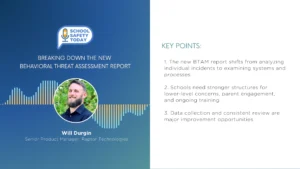School Districts Are Exploring Robot Surveillance on Campus But is This Realistic?
Join Mike Matranga, host of the SecurED Podcast, as he delves into the use of robot surveillance on K-12 campuses. The question at hand is whether this technology is viable or merely hype. Mike shares his perspective, emphasizing the importance of focusing on foundational components and behavioral threat assessment in the school environment.
From Mike’s viewpoint, while technology can provide a force multiplier for campuses, the use of robot surveillance is currently premature. He stresses the significance of establishing a solid foundation in identifying signs of pre-attack or self-harm behavior in individuals. While the technology may eventually prove effective, he believes that investing in it without prioritizing these fundamental aspects is wasteful.
Chris Caruso, COO and CTO of M6 Global Defense, adds his insights to the discussion. He acknowledges that robotic surveillance is not purely hype and can have its place in a school setting. However, he raises concerns about security, appropriateness, and the long-term financial sustainability of such technology. Data security and transmission, as well as the cost and ongoing maintenance, become crucial factors to consider.
Chris stresses the importance of evaluating technology for its long-term impact and practicality. He emphasizes that while robotics may offer some benefits, the human element remains irreplaceable in ensuring campus safety. Additionally, he highlights the financial burden associated with implementing and sustaining robotic surveillance systems, urging school districts to prioritize essential interventions and expert guidance.
Both Mike and Chris concur that it is premature to prioritize robot surveillance in schools, given the challenges and limited resources faced by many districts. Rather than being swayed by flashy innovations, they advocate for investing in experienced professionals who specialize in behavioral threat assessment and proactive preventative measures.
In conclusion, the discussion on robot surveillance in schools reveals a need for a balanced approach. While the technology may hold promise, it should not overshadow the importance of foundational components and human expertise in ensuring campus safety. By focusing on behavioral threat assessment and long-term sustainability, school districts can make informed decisions that prioritize the well-being of students and maintain their financial stability.








